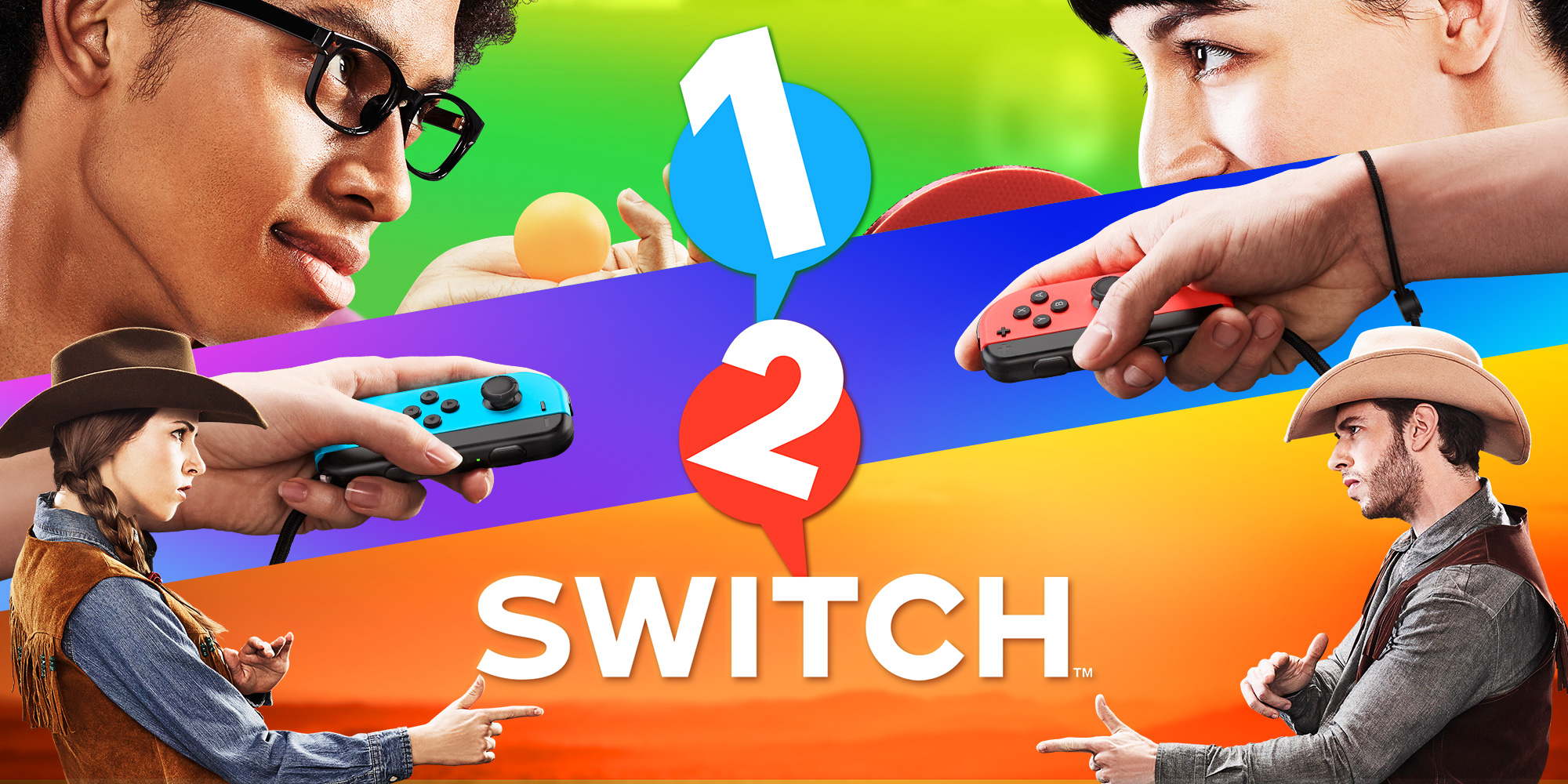Another Nintendo hardware generation means another tie-in minigame collection to explain the company’s latest hardware quirks. This represents excitement for some, cynicism for others, and overall a healthy pack-in option to make sure that people are starting their next-generation Nintendo experience off on the right foot, preferably with friends… Except 1-2-Switch isn’t a pack-in game this time.
Yes, Nintendo has made the frankly baffling decision to sell 1-2-Switch completely separately from the Nintendo Switch hardware itself, at least for the hardware’s launch window. Despite not being sold for full price, the collection isn’t cheap either. While all early Wii consoles came helpfully bundled with the standout Wii Sports back during that console’s first years, and you at least had the option of paying a slightly elevated price for a Deluxe Edition Wii U that included Nintendo Land as a free bonus during that console’s first years, in the case of the Nintendo Switch, you’ll have to suck up a separate $49.99 USD/$64.99 CDN expense if you want the latest batch of party-friendly minigames that show off your new Nintendo tech. A partner is also mandatory, since, in another baffling decision, 1-2-Switch doesn’t possess any true single-player mode, and is pretty much impossible to play by yourself.
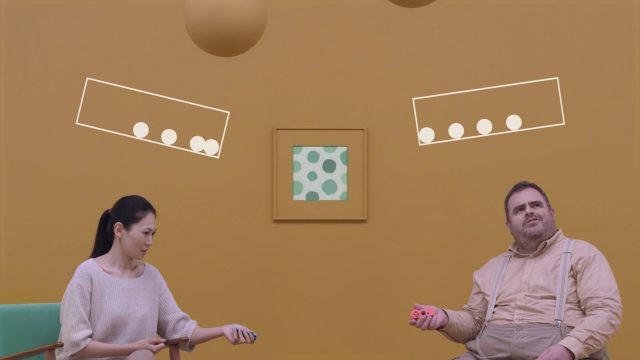
That’s immediately a pretty sizable ding against 1-2-Switch, even beyond the unreasonable price tag, especially with the behemoth release of The Legend of Zelda: Breath of the Wild proving to be a much bigger draw for the Switch’s launch among many early adopters. Heck, even fellow Switch launch title, Super Bomberman R, despite its modest content, is probably a better multiplayer draw for the hybrid platform’s launch window (assuming the fitness/music-based Just Dance 2017 doesn’t strike your fancy), until you can indulge in more robust multiplayer-focused titles to come like Mario Kart 8 Deluxe, Arms and Ultra Street Fighter II: The Final Challengers. Before long, 1-2-Switch is going to feel pretty obsolete within the Switch’s multiplayer game catalogue, especially with the hardware’s apparent lack of emphasis on Joy-Con-specific features in much of its current crop of upcoming games.
That’s not to say that 1-2-Switch isn’t fun. It can be decently goofy entertainment with the right group of people, especially if most of those people have never tried a Nintendo Switch before. The game does demand a pretty sizable disposable income to justify the cost though, since its simplistic minigames, while fairly plentiful, don’t offer any progression or rewards to help 1-2-Switch feel like a priority purchase for more serious Switch gamers especially. Compared to Wii Sports and Nintendo Land, 1-2-Switch just feels too anemic to be more than a passing novelty for passionate early Switch adopters, and it won’t be long before it runs out of tricks to impress you with.
1-2-Switch’s visual presentation does an acceptable job of getting you in the mood to act silly and party with your friends, but it’s also intentionally simple-looking. Much of the graphics consist of straightforward, cheesy and amusingly over-acted live-action video and images, which at least effectively convey how you’re supposed to indulge in each silly distraction, though they’re definitely not going to impress many people when the game is played on the television especially. The expected Nintendo charm is all over the visuals, which manage to be lively and vibrant enough to get the job done, though you’re definitely not getting a technical showcase to go along with your Joy-Con showcase here. Maybe that’s predictable, since so much of 1-2-Switch demands that you not even look at the screen, and instead focus on looking at the person that you’re playing against.
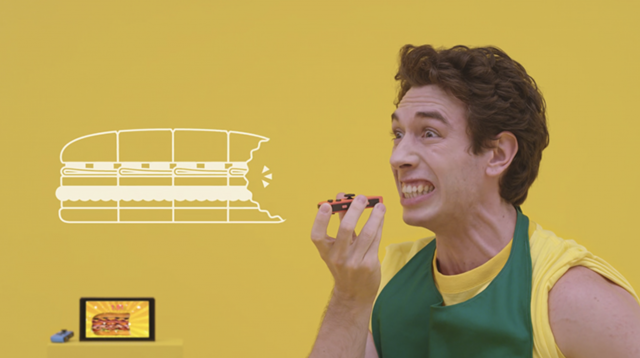
On the Switch’s handheld screen, the visuals of 1-2-Switch are significantly more impressive at least, and legitimately do manage to keep pace with several mid-to-high-end tablets in terms of rendering live-action video. You’re probably more likely to play 1-2-Switch on the television as opposed to Tabletop Mode though, especially since the game is predictably impossible to truly play in Handheld Mode for the most part, beyond one minigame, “Baby” recommending that you play in the portable format. Still, for what it’s worth, even if you’ll barely be paying attention to the game’s graphics in Tabletop Mode especially, the live-action visuals are at least a way to decently flex the technical prowess of the Switch’s handheld screen, even if other launch games like The Legend of Zelda: Breath of the Wild, Fast RMX or Super Bomberman R could probably also do that more efficiently.
Since you spend so little time looking at the screen in 1-2-Switch, especially during minigames, you’ll be relying on the audio quite a bit for guidance. As with the visuals though, the sound work is pretty straightforward and there’s not a lot to it. The goofy voiceovers, which largely consist of some disembodied male voices and female voices, depending on the minigame you’re playing, are easy to perceive and react to, whether on the television or on the handheld screen, and the same is true of the over-the-top sound effects that define each minigame.

A big part of the reason why playing 1-2-Switch on a television is preferable to playing in Tabletop Mode is because many of the minigames rely on the audio prompts being as defined and pronounced as possible, which is obviously a lot easier to do on television speakers over the Switch unit’s built-in speakers. It’s also true that the cartoon-ish sound effects feel more satisfying to listen to out of television speakers overall, where the signals of victory and defeat feel a lot more powerful and true. Each minigame has its own share of sound effects and voiceovers, and there don’t seem to be any weak links in the bunch, even if there obviously aren’t any standouts either.
1-2-Switch will ease you right into the experience by having two players each pick up one of the two requisite Joy-Cons (which the Switch hardware thankfully already provides out of the box!), and face each other to try their hand at the early batch of minigames. Naturally, standalone Joy-Cons are the only supported control method for 1-2-Switch in most of its package, with the exception of one minigame, “Baby”, which strangely breaks rank and recommends that you play in Handheld Mode. You won’t even have access to, “Baby” right away though, as it, and the bulk of other minigames, are locked away until you try your hand at a few of the more basic ones that the game provides as a sampler upon one’s first attempt at it.
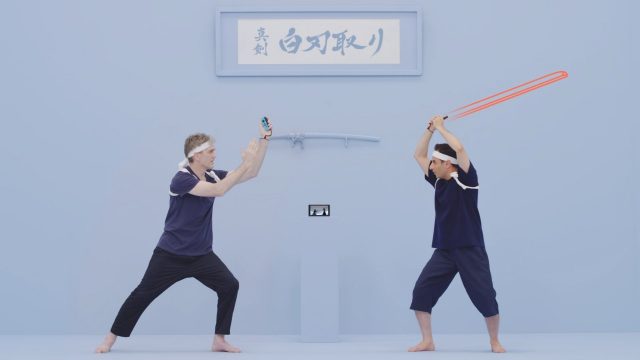
To be fair though, even if it doesn’t really make sense to herd you into a smaller batch of minigames before giving you access to all 28 minigames in 1-2-Switch’s package, the initial batch are probably going to be the minigames that first-time players would be most drawn to at the start of their play time anyway. These first minigames include: “Quick Draw”, which has you trying to thrust your Joy-Con forward and hit the ZL/ZR Button before your opponent does, “Samurai Training”, which has one player choosing when to swing a Joy-Con downward while another tries to clap their hands against their Joy-Con with the proper timing, “Zen”, where players have to try and hold a pose with their Joy-Con for as long as possible, “Copy Dance”, where one player does a dance move with their Joy-Con and the other player has to copy it, and, “Table Tennis”, where players have to swing their Joy-Cons with proper timing to keep an imaginary ping-pong ball moving.
As it stands, most of these minigames work fairly well, without many true derivatives in the package. Some minigames overlap, such as, “Fake Draw” essentially being another version of, “Quick Draw” that tries to fake out players with other words that start with, “F”, and, “Dance Battle” just feeling like a more freestyle-based version of, “Copy Dance”, but fortunately, most of the minigames are pretty distinct. There are some truly clever uses of the Joy-Cons in certain minigames too. “Ball Counting” makes for a pretty good showcase of the Joy-Cons’ HD Rumble capability for example, as players must guess the amount of imaginary rolling balls being simulated by their Joy-Con vibrations as the controller is moved around, while another standout minigame, “Safe Crack”, has players twisting their Joy-Cons to try and detect a separate vibration and hold on it, to disarm three imaginary locks on a safe before their opponent can, and before the two-minute time limit runs out.
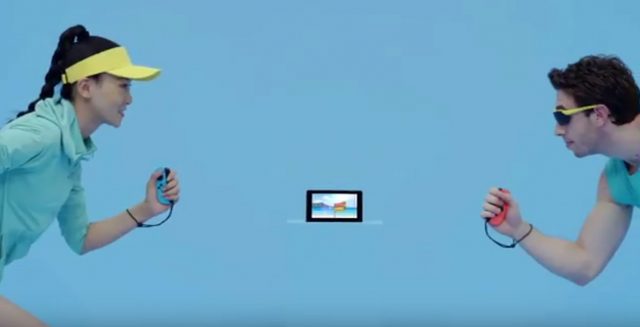
If you’ve indulged in the Wii and Wii U plenty though, then some of the minigames do feel like they’re re-treading some of the key gimmicks from the past two Nintendo consoles. “Eating Contest”, for example, which has players moving their lips as fast as possible over the Right Joy-Con’s IR Sensor to simulate eating sandwiches under a time limit, is pretty funny with a group of friends, but the whole IR hook was already pioneered pretty well with the Wii U. Likewise, as much as games like the previously mentioned, “Table Tennis”, or other competitive games like, “Sword Fight”, which has players swing their Joy-Cons to try and strike unguarded spots on their opponent, can be enjoyable for the first few times, their motion-based shenanigans are pretty much entirely unchanged from what the Wii showed off back during the previous decade.
Still, as a party game, 1-2-Switch does know how to get you goofing off and engaging with your friends well enough, especially if, again, the fitness/music-minded Just Dance 2017 isn’t your cup of tea as far as party games go. The uninhibited (and preferably intoxicated) adult crowd will definitely enjoy laughing at themselves in, “Runway” for example, a minigame that has you doing a hip-shaking walk and striking poses for an imaginary crowd (this is especially amusing with two male players, obviously!), and, “Soda”, a minigame where players shake a Joy-Con and pass it around, trying to use the HD Rumble to detect when the bottle will explode, are pretty good social uses of the Switch hardware, especially if you do happen to be taking 1-2-Switch on the go for whatever reason. Even, “Sneaky Dice”, a riff on real-life dice game, Liar’s Dice, is a surprisingly inspired way to use the Joy-Cons in a socially gratifying manner, as players must try to convince their opponent to roll the lowest number possible with imaginary dice, as they can feel the vibrations of their opponent’s total through their Joy-Con, but not their own total.
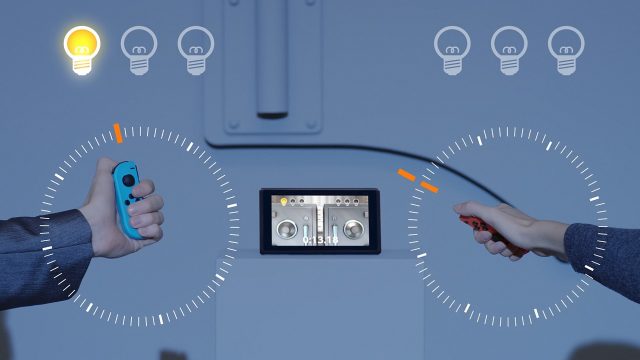
Predictably though, as is true of any minigame collection, some minigames in 1-2-Switch are pretty obvious duds. “Wizard” is pretty cool in concept for example, as it tasks players with spinning their Joy-Cons and trying to direct two dueling beams of energy, in an idea that is pretty blatantly stolen from the Harry Potter franchise, but it quickly degrades into imprecise Joy-Con flailing that lacks real refinement. Likewise, “Gorilla”, a game where players have to try and rhythmically make chest-beating gestures according to a rhythm with their Joy-Con (without actually hitting their chest, in a strange design quirk), is similarly imprecise, and annoyingly interrupts the game whenever a player doesn’t move the Joy-Con properly, which is never a good idea in a rhythm-based minigame! “Joy-Con Rotation” also feels very bland and frustrating, as players simply try to gently turn their Joy-Cons without jiggling them too much, lest they not get any points in one of three rounds.
Finally, the previously mentioned, “Baby” is a really bizarre black sheep, since it’s the one game that you’re supposed to play in Handheld Mode, as you try and cradle the Switch unit itself with both Joy-Cons slid back into it, then staying still until the baby on the screen wakes up, at which point you rhythmically cradle the Switch unit again. Not only is it rather inconvenient to take the Switch out of the dock and slide both Joy-Cons back into it for just one minigame (since you’re likely playing on a television), but this minigame’s controls are very fussy, and needlessly precise with how you hold the unit. Making matters worse is that the game doesn’t give you any pointers about how it wants you to hold the Switch unit (you have to place it against your bicep atop your forearm, with your chest close, on a very slight angle), and fails you out after a certain time, even if you otherwise follow the directions just fine. Not everyone will care, but at worst, this fussiness will frustrate more competitive players, on top of possibly causing social friction and discomfort with couples especially, particularly if their fellow competitors are parents that are bound to further mock their failings.

More than the small handful of dud minigames though, the biggest thing standing in the way of the value of 1-2-Switch is how rigid its play demands often are. With the exception of, “Eating Contest”, none of the minigames are truly playable solo, meaning that 1-2-Switch is pretty much useless if you don’t have at least one other person handy to play the game with you. As you can expect, that person needs to be right there in the room with you to boot, since 1-2-Switch obviously doesn’t support online play. It’s a party game, so the demand to be played with other people makes sense to a point, but even in the case of most other party games, you at least have some sort of option to play them by yourself. Heck, even Nintendo’s previous-generation showcase titles, Wii Sports and Nintendo Land, gave you solo play options, the option to play with the CPU, and even challenges and rewards to strive for if you were limited to playing by yourself. 1-2-Switch doesn’t offer any of that. It doesn’t even offer any play progression or bonus challenges to strive for at all, further hurting its longevity, especially when bigger, better multiplayer/party game mainstays start coming to the Switch in the future.
As I said, you can get a decent party started with 1-2-Switch if you bring the right crowd, especially since you at least have the option of pairing larger groups into two teams that rotate between minigames, as well as the option of letting the game randomly choose minigames for you, to keep players on their toes. In just a couple of hours though, you’ll have seen everything you can do with 1-2-Switch, especially when the game lacks any means of being played solo, or striving for any reward beyond giggles with your friends. This feels more like a tech demo than a truly fleshed-out game experience, and the fact that the game is significantly less-featured than even Wii Sports, which was a free pack-in game for the Wii from a decade ago, is pretty inexcusable.
It’s tough to truly call 1-2-Switch a bad game, since most of its minigames work perfectly, feel creative, and are pretty enjoyable to play with friends while they last. Even being a fairly solid showcase of the Switch’s new Joy-Con controllers though, there’s no getting around the fact that 1-2-Switch is an overpriced rip-off, charging an unacceptably high cost that’s only slightly below the full retail sum. That’s even worse when you consider that 1-2-Switch is designed like a tech demo and a pack-in game, despite not being bundled with the Switch hardware. Again, when the Wii came packaged with Wii Sports during its own launch, which didn’t seem to affect that console’s price to any serious degree, what’s 1-2-Switch’s excuse for being forcibly sold separately by Nintendo?
That’s also before considering the rigid play demands, which almost certainly require playing on a television for the most part, being alright with using the motion controls and HD Rumble feature of the Joy-Cons to drive gameplay, and, most annoying of all, accepting a gameplay experience that is completely inaccessible to anyone that didn’t bring at least one friend. If you’re a solo player, then 1-2-Switch won’t even let you past its opening prompt, so don’t even bother with it if you don’t have a local friend, family member, child, or partner/spouse to play with.
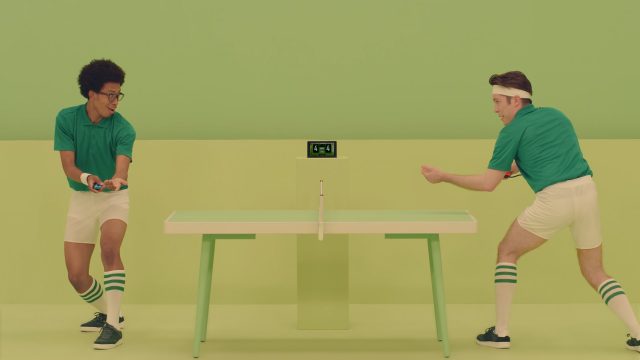
Even if you do have other people to play with though, there’s plenty of superior multiplayer games available for Nintendo Switch already, whether competitive or co-operative, between Just Dance 2017, Super Bomberman R, Fast RMX and Snipperclips, let alone the surely superior multiplayer games that will arrive on the platform in the future. Unless you really want to show off the Switch’s Joy-Con capabilities to your friends, and have a sizable amount of money to throw around on game purchases, there just isn’t much of a reason to buy 1-2-Switch, even for more casual gamers, let alone more avid gamers that are probably going to dive into The Legend of Zelda: Breath of the Wild throughout the Switch’s launch window, and not look back.
As I and many others have repeatedly stressed, 1-2-Switch should have been a free pack-in game included with every Nintendo Switch hardware purchase, since it barely has a leg to stand on as a separate product. When Nintendo can bundle a more fully-featured and superior pack-in game with the Wii for free all the way back in 2006, you can’t honestly tell consumers in 2017 that 1-2-Switch would have had any reason to hike up the Switch’s price that much.

